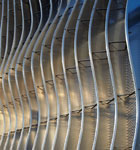 When Stacey Jones got a call from Bill Zahner, president of powerhouse steel-fabrication firm A. Zahner Co., Jones knew he was in for a challenge and a treat. Zahner was looking to renovate his Kansas City, Missouri, assembly building, and Jones, a principal at Crawford Architects, more than delivered. What he ended up creating was a billowing, avant-garde curtain wall of glass and aluminum nicknamed the Cloud Wall. By encircling the building with undulating vertical-steel columns, Jones created a horizontal rippling effect to emulate sand in the wind. Here, Jones discusses working with Bill Zahner and how using the engineering firm’s own advanced systems helped create this exciting new showcase for both companies.
When Stacey Jones got a call from Bill Zahner, president of powerhouse steel-fabrication firm A. Zahner Co., Jones knew he was in for a challenge and a treat. Zahner was looking to renovate his Kansas City, Missouri, assembly building, and Jones, a principal at Crawford Architects, more than delivered. What he ended up creating was a billowing, avant-garde curtain wall of glass and aluminum nicknamed the Cloud Wall. By encircling the building with undulating vertical-steel columns, Jones created a horizontal rippling effect to emulate sand in the wind. Here, Jones discusses working with Bill Zahner and how using the engineering firm’s own advanced systems helped create this exciting new showcase for both companies.
What led Zahner to approach your firm about this project?
Their work [had] expanded dramatically to the point where their current factory wasn’t considered large enough to handle the workload. Bill came to me with an idea and asked if I would be the architect for the expansion. I was flattered.
What were the initial discussions about the design?
What he wanted to do was consolidate his campus with some kind of closure but also create an environment where he could bring prospective customers and showcase his work.

Stacey Jones, principal of Crawford Architects, was charged with taking Zahner’s panel system and using it in an innovative way for Zahner’s factory expansion. The completed model shows his final concept: patterning the facade with a skinless version of the system to create a hypnotic pattern.
How did you accomplish that?
[Bill] challenged me to come up with something that was extraordinary. He wanted to do that using a new product, this Zahner-engineered proprietary paneled system, which is basically a skeletal frame that one can wrap [a] skin over … to produce whatever form you want. It was never used in this way before.
How so? Can you describe the process?
The façade utilizes a variation of the ZEPP [Zahner Engineered Proprietary Panel] system but strays from the traditional project, in which a metal skin is applied to the steel backup system. The skin is absent, thereby exposing and expressing the structural skeleton beneath. Clients … can see first-hand Zahner’s ability to engineer complicated forms.

The Cloud Wall wraps the exterior of the assembly building, undulating in a pattern that Jones says was inspired by ripples of sand.
What inspired the look of the façade?
For inspiration, we looked at a whole bunch of things from nature—clouds and trees and ripples of sand in water—and we came up with a sketch that we could then scan. We used that drawing as inspiration for the façade and sliced that drawing into two vertical panels, and—along each of those—we produced the shape.
Let’s talk about the natural light the building offers. Why was that important?
Internally it makes for a really nice work environment. In between the fins are alternating clean-glass panels. The building faces primarily north, so solar exposure wasn’t a great concern. On the east and the west [sides], which are the short façades, the fins act as a solid block of that low-angle incidental light you get in the early mornings. That means there are very few fluorescent lights on during the day. I think that the light level makes for a safe and quality working environment—as well as being energy-efficient.

From the inside, the assembly building’s structural bay benefits from the extensive natural light that enters from between the facade’s fins.
In what other ways was sustainability a part of this project?
The ventilation was another component. There are some exhaust fans on the southern side that exhaust hot air that has been accumulated on the top of the factory. There are low-level vents on the northern side that draw in cooler air on the lower level. [We also considered] basic principals of sound—and reusing existing structures, as we were able to use a lot of columns already there so we didn’t need to tear down a lot of stuff.
You worked closely with Bill Zahner on this project. How much involvement did he actually have in the design phase?
Because it was something that represented his work and his art form, [Bill] probably had more to say than a normal client would have. It was certainly something that was instrumental to the production. He was keenly interested in showcasing the new product he had in the ZEPP panels. Bill also gave us more or less free reign to come up with something he would be excited about and comfortable about.
——————
This is one part of gb&d’s Technology Symposium. Read more here.

